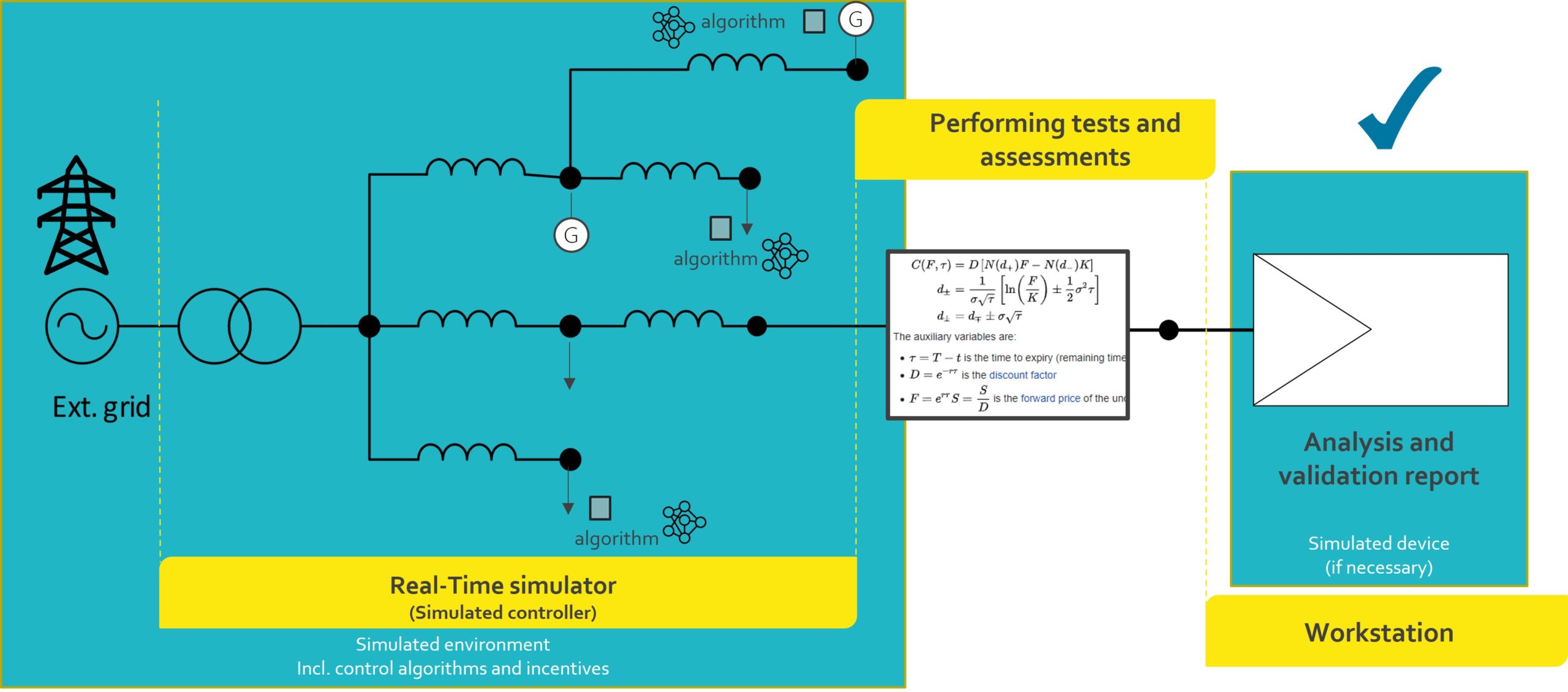Software in the Loop Testing for the Electricity System
Combined software and hardware in the loop tests for distribution grids and isolated power systems with high RES penetration
Partner: DNV GLActors involved: Provider of the Control/decision Software under Test (SUT), System operator opting to apply the SUT
Context |
The power system is becoming increasingly more complex to operate, due to the increase of variable energy sources such as wind and solar, and means to integrate these sources into the power system, such as demand response, battery systems and power electronics.
The control and optimization of this system is increasingly becoming more digitalized and automated, by the implementation of advanced and complicated algorithms for control and optimization of this system, both on decentral—device and subsystem—level as on central—system—level.
Experiments with hardware in the loop (HIL) testing have been going on for a couple of years. These tests involve a detailed assessment of the interaction of a device controller with a simulated power system.
Software-in-the-loop (SIL) is a variant of HIL, and allows testing of control and optimization software prior to the initialization of the hardware prototyping phase in a complex environment, consisting of the power system, including other control and optimization algorithms that might interfere with the software or algorithm under test.
In other words, SIL is a test methodology where algorithms are tested within a practical, virtual simulation environment intended for the validation and testing of detailed control and optimization strategies within large and complex systems.
SIL offers numerous advantages. It reduces the risks of unforseen effects of applying advanced algorithms in complex environments, and enables early detection of system defects and bugs. It provides an efficient means to validate the save application of such software under all forseen circumstances.
Summary |
The objective of this use case is to examine the assurance of control and decision support software in the electricity system, by testing it in a complex simulated environment. The aim is to assess the risks of applying the software in the actual power system with regard to its robustness, accuracy, precision and potential risks of interference with the power system or other control algorithms.
Actions will entail:
– Environment development: Model parts of power systems (all aspects, and different systems)
– Definition of testing protocols and (robustness, accuracy, interactions, etc.)
– Putting algorithm under test (If run as a ‘black box’, this might require the simulation to run real time)
– Actual testing for robustness, reliability, cyber security, etc., claim of accuracy, precision, etc.…, potential risks.
It should be noted that in the project the reached results will be demonstrated with 1 or 2 of the developed tools.
Challenge |
How can we control and optimize the software in the electricity system while avoiding algorithms’ interactions and grid interference that can lead to undesirable outcomes?

Example of possible problems
• Instabilities (controllers/incentives reacting on each-other)
• Over voltages/currents
• Power Quality issues (e.g., harmonics)
• Contradictory incentives (e.g., Local (semi)autonomous vs top down scada)
• Implementation of intelligence/reinforced learning can become unpredictable
• Gaming/monopolization of flexibility
Control algorithms become smarter and trying to optimize devices they control.
However, there is no validation of their effects on system level and if the possibly pose a threat to the integrity of the system if implemented at scale.
Approach |
Create a test facility able to test claims about control and optimization software in the electricity system and assess possible interference with other aspects of the system.
Innovative content of forecasting solution
SIL takes a parallel path to HIL and focusses on possible interference of control algorithms and intelligence within the power system.
| KPI1 | An assessment of an in Smart4RES developed algorithm (as black box). |
| KPI2 | Development of a best practice for the validation of claims on algorithms. |
| KPI3 | Demonstration of a software in the loop run using an example from the project. |
| KPI4 | Simulated environment with including controls and interaction. |
| KPI5 | Test protocol to test for (at least) one potential risk. |
